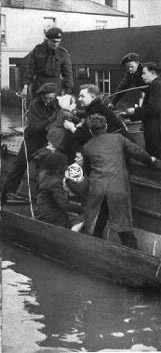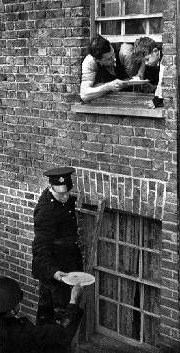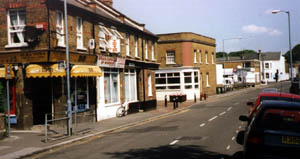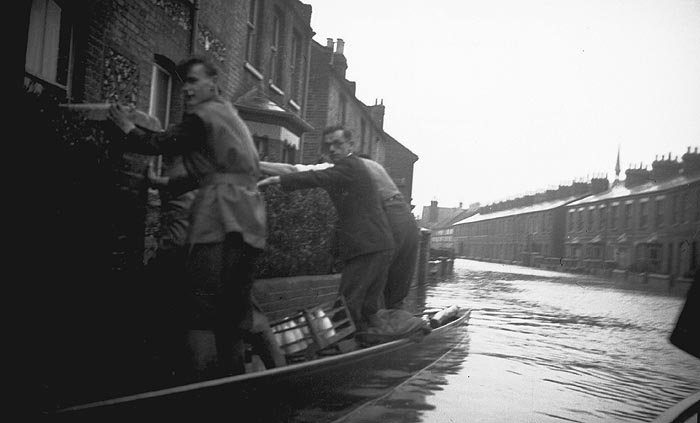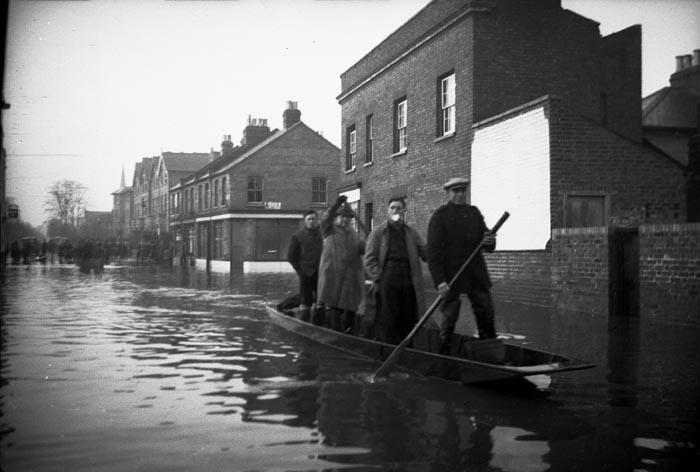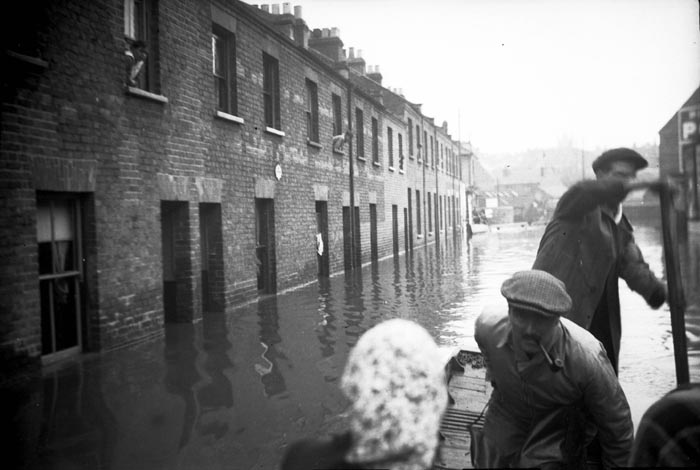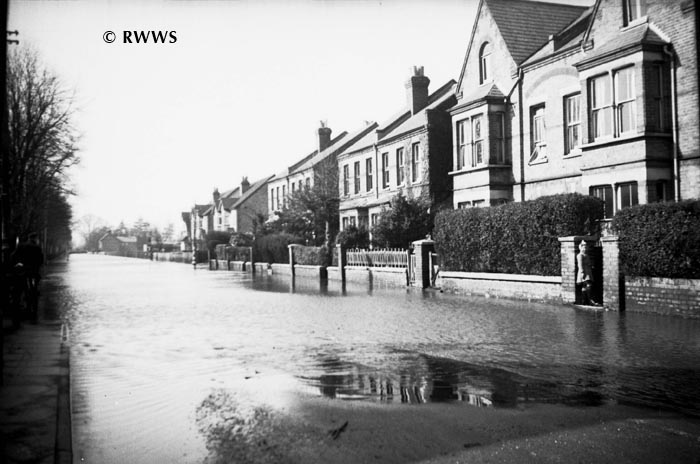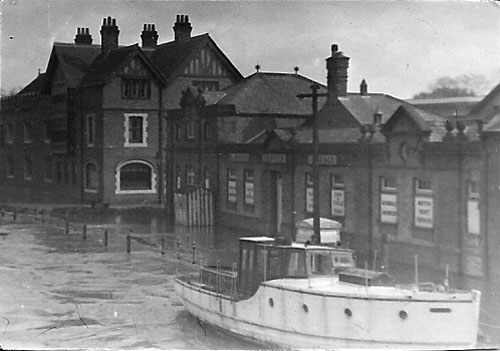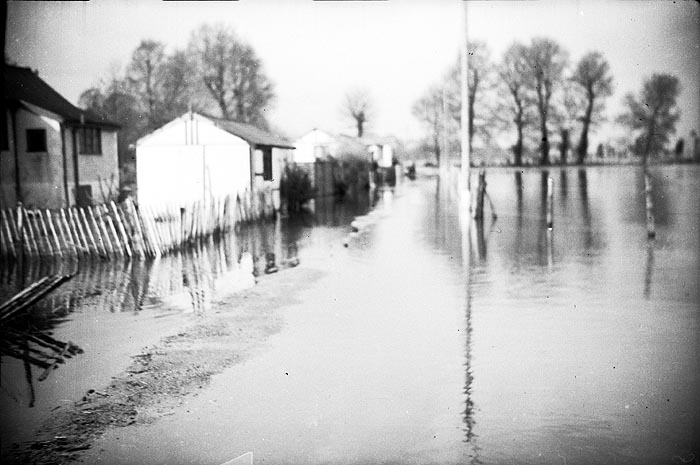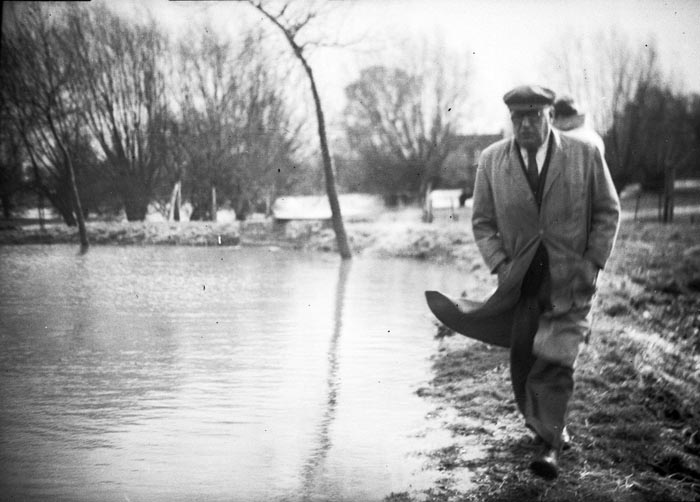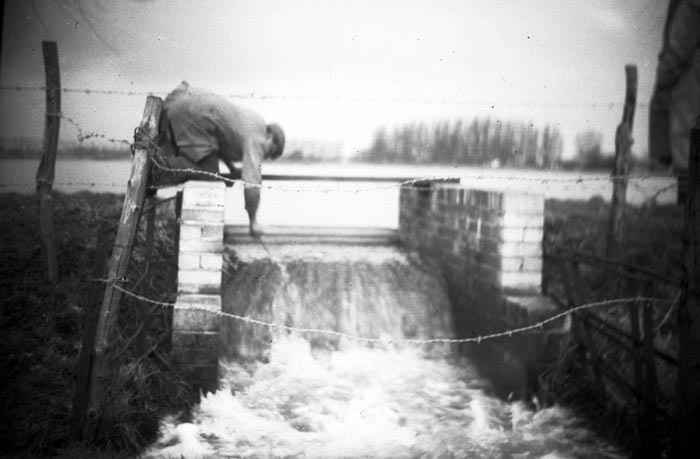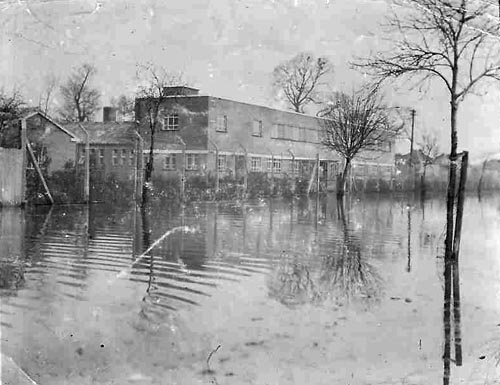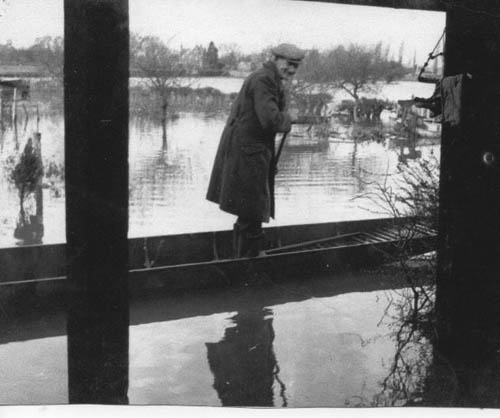
Windsor Flood 2014 News & Views Windsor's Thames Forum 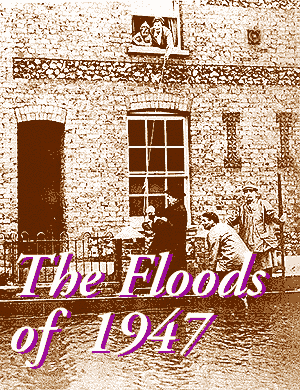 |
|
a picture drawn by her son, Mark |
|
The following story was written by the late Gordon Cullingham, former Borough Engineer of Windsor, who was closely involved in the event at the time. We are grateful to the Windsor Local History Publications Group for permission to include the original article which has been updated substantially since.
NB All photographs are copyright The Royal Windsor Website or as noted. Please contact the editor before using on other web sites or printed publications. To contact us, email Thamesweb.
Cold black flood water creeping inexorably towards one's home is an appalling sight. Many residents of Windsor, Clewer, Eton and Old Windsor suffered this experience when the Thames flood swept down the valley in March 1947. Centuries of floods have carved the Thames Valley into what it is, and while work has been done to reduce or even obviate the effects of 'ordinary' floods, catastrophic floods (such as the records show occur on average two or three times every century) will still occur. Therefore everyone with property in the flood area should be insured against flood damage. Reading the small print on a policy AFTER flooding can be frustrating because some policies exclude flood damage unless an extra premium has been paid. 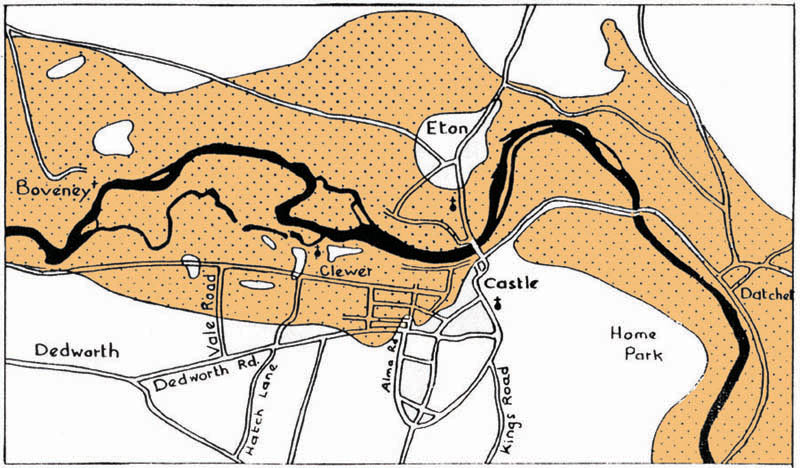 White areas within the flood area are slightly higher and escaped flooding. How often we are told that the weather is the coldest or wettest or whatever for many years, but the truth is that history is only repeating itself, and that catastrophic floods have occurred since times ancient, beyond records. The usual aftermath is to 'be prepared' for the next one, but when the interval is a long one, memories fade and optimism replaces knowledge of the facts, which are that while the river board engineers carry out works and maintenance that tend to contain 'ordinary' floods, catastrophic floods are, and always will be, virtually uncontrollable. The Chief Engineer stated in his report after the 1947 flood that it would take two, or even three, rivers to contain the volume of flood water rushing down the valley after abnormal rain, especially when the land is supersaturated or, as in 1947, rendered impervious by deep frost and aggravated by substantial snow drifts. The Deputy Ranger of Windsor Great Park, Sir Eric Savill, said in 1947 that the water ran off the Park as off a slate roof. This resulted in local flooding from streams such as the Bourne Brook in the Bourne Avenue-Victor Road area, when the stream burst its banks and flowed through the houses in its path. This was two or three days before the main flood reached Windsor. No warning was given. It seemed as though the winter would never end in 1946/47. It had been a poor summer, the war had left everyone more or less exhausted, and January brought frost and snow. February was even worse with snow covering most of the country. In hilly districts villages were marooned, trains snowed up and cars lost in drifts. Stocks of fuel were low, and there were power cuts. Coke could be obtained from the gasworks if you took your own sack and barrow as gas in those days was made from coal and oil. Natural gas was unheard of. There had been a minor flood in December, but nothing much except that the ground was becoming saturated, and the snow represented whole lakes of water if there was a sudden thaw. And there was. In addition, heavy rain fell on March 10th, followed by even heavier rain - nearly one inch (2.5 cm). On March 14th the thawing snows could not drain into the frozen ground and so the water continued down hill into the streams and rivers. These rose at an alarming rate - sometimes almost a foot (30 cm) an hour. Old hands prepared to visit relatives living on high ground. The Thames topped its banks on 14th March as did other rivers. The Colne flooded Denham, part of Iver was inundated and Colnbrook High Street was up to 18 inches (45 cm) deep. Saturday brought floods to Wraysbury, Welley Road was a sheet of water, Boveney and Dorney. At Windsor the Borough Engineer Geoffrey Baker called a staff meeting, and arrangements were made to watch the river level at the Race Course and upstream, day and night. Soon the water spread southwards, checking for a while in Clewer at the ancient road line along the Balloon Meadow northern boundary, then rolling across Maidenhead Road and up Vale Road. 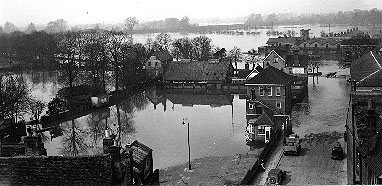 In the distance, across the river proper, The Brocas flooded too. 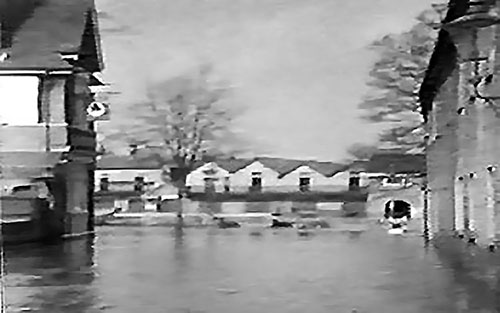
There were only vague
recollections from the oldest inhabitants about the
disastrous flood of 1894, except one Oxford Road
lady who said SHE had been flooded twice
before and felt a bit old for a third inundation, so
could she please be evacuated and could someone get
her furniture upstairs. There was a lot of
unco-ordinated activity by the pessimists, while the
optimists stayed warm and dry indoors until the
water started to come up through their floorboards
and oozed up from low places in their gardens.
Bungalows and ground floor dwellings had to be
evacuated. The services, telephones, gas and
electricity, began to fail. 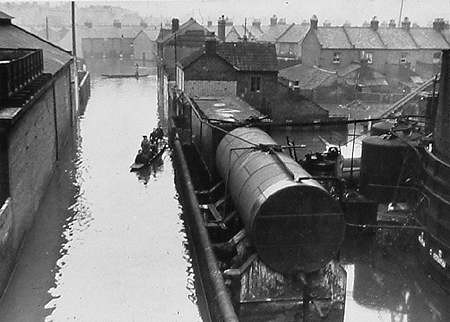 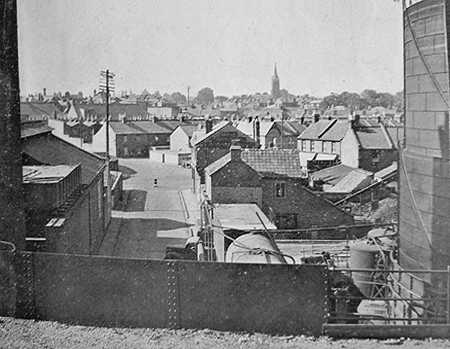 There was a run on candles and were soon sold out. Paraffin lamps were improvised, some rather dangerously so, with wicks pulled through a hole in the top of a tin. The electric railway at Datchet became a canal between the platforms, as it did at Wraysbury. The Great Western line to Slough kept going, with its steam trains, but the coal yard was flooded [Now the Coach and Car Park beside Alexandra Gardens. Ed.] and the water swirling around the arches looked ominous. 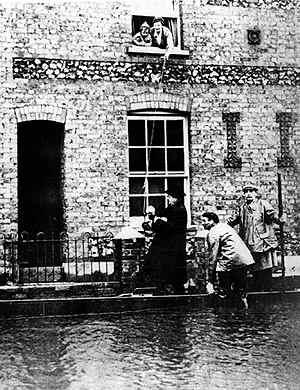 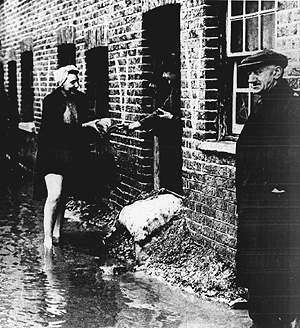 the floods rising up from the ground and through the drains and sewers. Meetings in every parish tried to cope with the situation, but requests for help could not be acceded to as nearly everyone in the flooded valleys of England had their own troubles. Maidenhead was flooded throughout its low-lying areas and Eton was badly affected as were parts of Staines. The story of an accident at Welley Corner was circulating. A lorry carrying evacuees ran off the road, no telephones were working in the vicinity, but there was an amateur radio operator nearby and a message asking for help was transmitted. Someone in Italy heard the call, passed it on to London from whence the police telephoned Slough, but by this time help had already reached the stranded party. While large areas were in serious trouble, many others were trouble free and complaints poured in to the local authorities from residents unaffected by the floods about dustbins that had not been emptied. This was because the refuse freighters could not reach the tips, and the men were manning the boats.
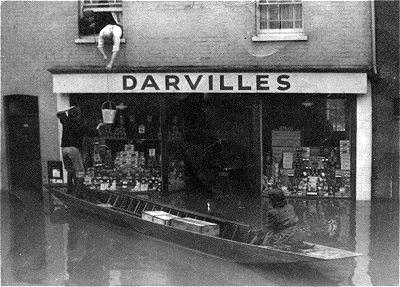
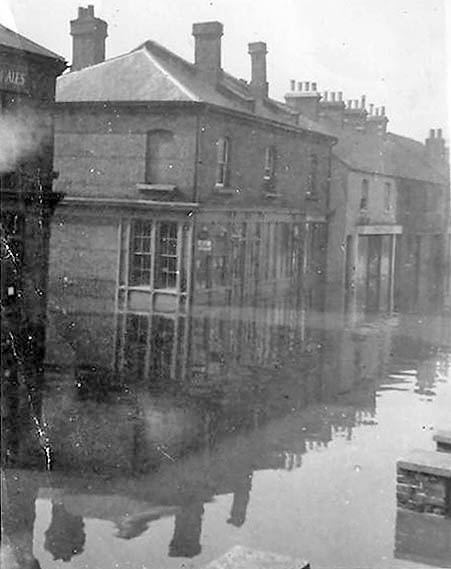
Mail arrived more or less as normal but letters into the Council offices were stamped 'DELAYED BY FLOODS' just in case of trouble later.  From the original rubber stamp used by the Council on incoming mail, 1947. Along the river bank upstream, trees were in danger of being uprooted and swept away, thus putting Windsor Bridge, with its vital services, at risk, so the trees were blown up by a party of Scots Guards from Victoria Barracks. Arrangements were also made for this party to blow up any large boats that broke away from their moorings and swept downstream - as St Marks' "Ark" had been (see sketch in the Eton College "Deucalionea", page 3) (See story Windsor Bridge) 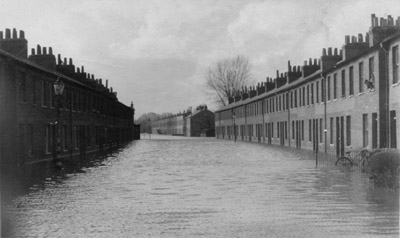
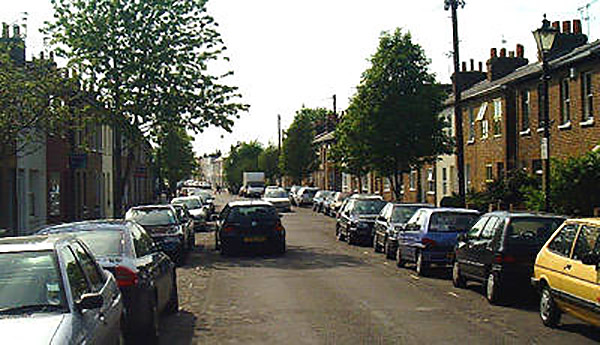
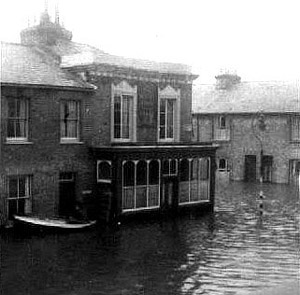 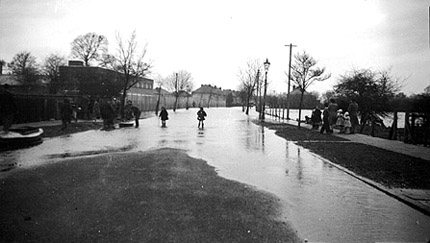 The roar and vibration from the mass of water passing under Windsor Bridge was alarming. Afterwards it was found that large round boulders had rolled downstream, swept along by the raging torrent, and a mass of sand and gravel had collected at Romney Weir. Clewer Village was an island around the church, Maidenhead Road was impassable by car, as were Vale Road, see above, Buckland Crescent, Rays Avenue, Arthur Road, Vansittart Road and Alma Road, north of Bexley Street. At the end of Bexley Street, the flood water was approximately 60cms (2') deep in The Bexley Arms and the water extended east to number 80. The Vansittart Arms, slightly to the north and on a rise in the road, was not affected. Boats plied to and from the slope in Alma Road by what was then 'The Clarence Hotel', near what is now the 'Copper Horse' in Ward Royal. The latter is built upon the site of several streets that were flooded in 1894 and 1947, including Sydney Place, which was another embarkation place. Traffic between Dedworth and Windsor had to use Imperial Road or go via Clewer Green as Clarence Road was impassable between Imperial Road and Alma Road. Imperial Road soon became potholed and corrugated under the weight of traffic, as its clay subsoil was saturated. 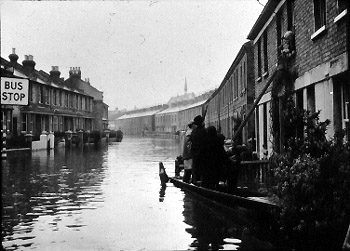
Oxford Road was a river and an odd stream of gas meters floated along Goswell Road from the gasworks and the coke pile at The Grammar School for Boys in Maidenhead Road slowly streamed away in the flood. A pupil from Clewer St Stephens has reported that all the exam papers were floating down Arthur Road and that the 11 Plus exams were delayed. "My sister and I thought it was great fun as there were punts coming along the road throwing bread and dried goods up to us. We were given tins of Horlicks and Ovaltine tablets, as good as sweets to us in times of rationing." Eton High Street was just passable but the wash from vehicles damaged shop fronts and doors. This was a common danger wherever vehicles could still move. If you went slowly you might stop in the floodwater. Going faster gave a chance of rolling out by momentum if the engine stopped as it often did. But a fast moving vehicle was a menace with its 'bow wave' like a destroyer, breaking down garden walls and fences, shop windows and doors. This was one problem that sandbags could, to a degree, alleviate. The basement of the Theatre Royal was flooded, as were basements in many places remote from the flooded area, and some not so remote such as Clarence Crescent, due to surcharged sewers. 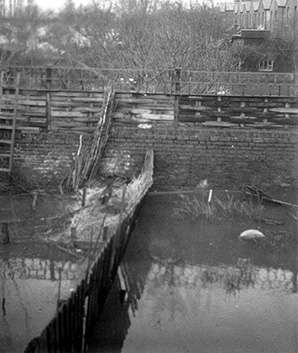 was living at the time.
Geoffrey Baker's Borough Engineer's Department worked 24 hours a day, initially from the old depot at 16 Alma Road (now Ward Royal) and then, as the floods deepened, the CID room at the old St Leonard's Road Police Station was offered. This offer had to be withdrawn as the volume of telephone traffic swamped its small switchboard. Then Windsor Telephone Exchange came to the rescue. There was a basement under the old Exchange on Bachelors Acre and the GPO engineers were soon festooning the ceiling with emergency lines from the manual exchange above, dropping leads to telephones on furniture hurriedly assembled below, including bunks from air raid shelters not yet cleared. Posters were printed showing who was doing what, and where communications were a problem. There were sections to deal with water purity tests and chemical closet emptying. Several hundred such WCs were obtained from a building contractor together with a high platform diesel lorry from which someone solemnly did what was necessary to enable upstairs residents with no WC to enjoy home comforts. Emergency work by guardsmen, called by the Borough Engineer on a Scots Guards radio, erected dams of clay collected from the Princess Avenue housing development site to protect the Eton Waterworks wells at Tangier Lane, and, even more vital, the electric power transformer. As this work was in full swing, Mr Gosling, an electricity board engineer, stood by to switch off as the water rose to within half an inch (1.2 cm) of the 'certain danger' level. The electric motors were kept running by this tiny margin and the water supply of Windsor and Eton was maintained. In 1894 the flood had stopped the pumps. When the Borough Engineer personally cleared the baulks of timber closing the gap in the river wall at the Railway Arches in Barry Avenue, a torrent of impounded water swept the timbers away, as the river level had by then dropped well below the land flood level. Barry Avenue was the result of the flood protection work undertaken many years previously by Mayor Frederick Dyson, whose memorial drinking fountain is by the river, opposite Goswell Road. [See Barry Avenue Promenade story]. Town refuse had been tipped for a long period to raise the road level above that of Alexandra Gardens. In 1947 the latter remained a lake for many weeks after the rest of the flood water drained away, necessitating batteries of great pumps working night and day to clear it. 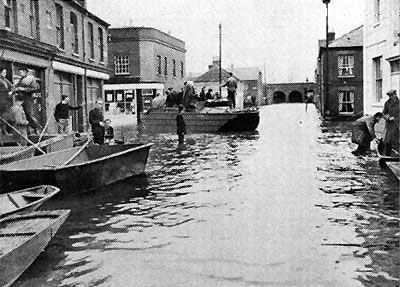
Many of the 1947 'relief' facilities are no longer available. Who can now commandeer a fleet of punts? These were manned by a detachment of Scots guardsmen whose NCO thought the situation could be dealt with as if it was a parade ground exercise. Every punt turned on its side and sank as the soldiers stepped in on one side with military precision! After that, they entered the boats more 'Navy fashion'. The punts were brought to the old Borough Depot in Alma Road by the soldiers who waded chest deep along Romney Walk to bring them into the town. Bachelors Acre was a transport park where RAF sleeping vans and private caravans were used by the relief workers to snatch a few hours sleep. The Royal Free School provided an emergency canteen for workers, and for residents displaced by the floods. Windsorian Coaches, flooded out from their premises in Alma Road, were parked on Church House school field, land now occupied by Windsor and Maidenhead College. War surplus building materials and other scarce supplies were brought from the abundance of the American Forces depot on the racecourse at Newbury. We were allowed to take anything useful for flood relief, the lorries having to take devious routes to avoid the flooded roads. NALGO members at Windsor decided not to claim overtime for the long hours. Some worked all night to arrange emergency services such as milk distribution from temporary depots at the edge of the flooded area, from which the roundsmen wearing thigh boots could either pull punts loaded with crates, or try to pull themselves along a flooded street by clutching at the front walls and fences. Steam trains were able to evacuate the Eton College boys in 1894 but electric trains were unable to get through the floods at Datchet in 1947. Here the only public transport was a DUKW. Another of these amphibious vehicles served Clewer from a depot in Sydney Place and the marks where it got stuck under the railway arch at Barry Avenue at 2 a.m. one morning can still be seen. [Editor's Note: Gordon Cullingham was actually on this vehicle at the time, with his wife Mollie. He said he wasn't driving!] 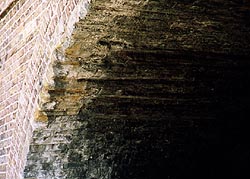 caused by an DUKW forcing its way through. That journey was to collect waterworks repair man Bob Press from Gardner Cottages in Arthur Road, to deal with a burst main in Peascod Street. Water mains and service pipes tended to break under the softened roads and footpaths, sometimes by reason of heavy vehicles taking to the higher footpaths, out of the more deeply flooded roads. Warnings were given to boil drinking water, which was not easy without gas or electricity. A glimmer of gas was left in the flooded mains but was not to be used because of the risk of explosion from air entering the pipes. Coal was inaccessible in the flood, some people were able to get wood blocks from the old surfacing of the High Street in Windsor which fortuitously was being stripped and replaced by asphalt - until the snow stopped progress. Candles were scarce. Some were delivered by the late Councillor Ken Darville as part of his shop's '5/- (25p) emergency ration packet', the contents of which included cooking fat and margarine and similar basic items. Mr Darville waded in thigh boots behind a high platform, diesel lorry which could still get through the floods. Many vehicles were brought to a standstill because the exhausts became submerged, or the ignition was swamped. Windsor Council provided lines with hooks at one end which could be lowered from a bedroom window to the milkman or postman who also came round by boat. One baker specialised in throwing loaves through open bedroom windows, his aim eventually became quite good. The many pairs of thigh boots required were secured by sending a taxi to London to get a stock before everyone else got there. Rubber boots and naval sea boot stockings were similarly obtained from Admiralty stores. The sea boot stockings, in oiled wool, saved many a flood worker from getting bad feet due to the long hours in rubber boots. Those residents who were able to remain in their homes did not get much sleep with the roar from the river in flood nearby and the passage of boats carrying workers around for one reason or another. The nights were moonless, there were no street lights and it was a bit hairy rowing along a flooded street, lit only by the odd candle left burning in a window to guide someone home. You could, of course, sing the 'Song of the Volga Boatman' or the 'Eton Boating Song', to keep up your spirits! Mayor Fuzzens sent an SOS to Whitehall which was headlined on the front page of the Sunday Express. All the Government departments responded, especially the RAF and the Navy. The Medical Officer of Health, Dr M T Jones, and his staff arranged evacuation of bedridden and disabled people. The ambulance men sometimes had to slide a stretcher somewhat alarmingly down a steep ladder, and surveys to find out who was in need of help went on continuously. A convoy of RAF radio lorries arrived at midnight and the crews were somehow fed and distributed to replace flooded telephone communications. Some pub cellars flooded which did not improve the beer. Sanitary lnspectors led by F. Arnold were kept busy checking and condemning flood-contaminated rationed foods, including butter and cooking fats, so that shop-keepers could get replacements. Each service tried to keep the others informed of points of interest but it was some time before chaos was more or less ended - in the opinion of the staff, if not the victims. By the 20th March it seemed that the peak had been reached and the waters began slowly to fall. [The peak level has been reported to be 6' 8", almost exactly 2 metres, above normal - Editor]. After a period of days the time finally came when the street gullies could be seen as whirlpools. 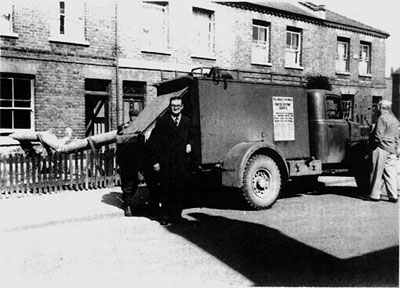 The crowns of the higher roads and footpaths reappeared only to be found to be covered with stinking silt. In times of flood, operating the cistern merely transfers the sewage from the lavatory pan to the street. Men with hoses could wash down contaminated streets but housewives were faced with soaked carpets, ruined linoleum, clothes, boots and shoes and other articles lost on the floor during the flood. Few articles of furniture survived unharmed. People were anxious to get back into their houses but cesspools had been flooded, sewers had overflowed, and there was an obvious health problem. In the event, supplies of 'off-the-ration' soap, disinfectant, and even American washing machine detergent, were distributed and the great mopping-up and spring-cleaning commenced. Pathetic piles of ruined goods were put out for the dustmen. Clothing was still rationed and coupons were necessary to get replacements. The allocation was meagre. Replacement furniture was also scarce, some 'utility' was available on special coupon, but only if you had children. Large pumps were mobilised to get rid of the pockets and large pools of water, stagnant and smelly, which appeared to be another health hazard. Aircraft engine heaters and hot air hoses were borrowed from British European Airways (B.E.A.) at Heathrow and other airfields to help dry over 300 saturated rooms, each requiring 10 gallons of petrol at 2 shillings (10p) per gallon, but the hot air split wooden furniture and drying wallpaper peeled off the damp walls and smelt horrible. Laundries helped to clean and dry mattresses and bedding and an untold amount of help was given without thought of reward or payment. 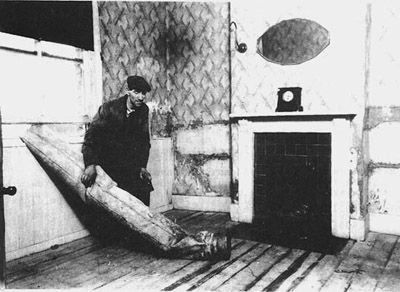 But eventually the sun shone again, the cherry and almond trees burst into bloom. The Town Clerk, R. Webster Storr, and the Borough Engineer, G.S. Baker, wrote their reports (the Borough Engineer headed his 'FOR MY SUCCESSOR' - I wonder where the new Authority keep their copy). The Borough Accountant, D.R. Harman, totted up the cost - over £120,000 for relief measures. Some of this came from the Lord Mayor of London's Fund which was subscribed to world-wide, much given by countries now regarded as very poor, and even Third World countries now in serious trouble themselves. Gifts from overseas poured in from Canada, America, South Africa, Australia and New Zealand, and other well-wishers. Some came via the Red Cross. A million pounds was added by the Government. In Windsor, a flat rate grant of £7 was paid for lost linoleum and other claims were examined by the Rent Officer, Mr Bellringer, for a further grant. When it was all over, several thousand pounds remained and were put into a Mayoral Fund 'for the next time'. There was a clamour for a warning system, which was eventually devised. A reminder of this for some years was the coloured disc board in the window of the Main Post Office in Peascod Street. These were also maintained at 10 or so other sites around the various districts. Flood wardens were appointed, and given thigh boots, but of course these appointments have since faded away. A prohibition on building in the flood area of Windsor was proposed and defeated, except that ground floor levels of new dwellings have to be at least as high as the 1947 level in the various areas. 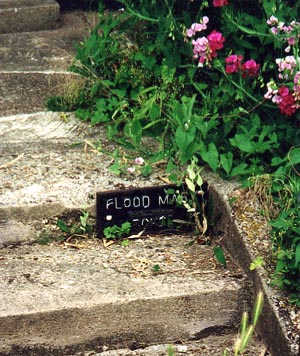 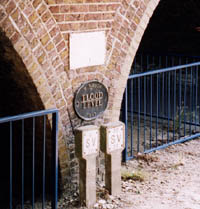 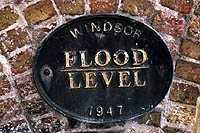 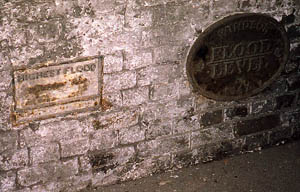 The river bursts its banks and overflows above Clewer at the site known in medieval times as 'Breach Field'. It then fills the 'saucer' formed by the boundaries of the river wall and the higher parts of the town, and cannot escape downstream easily. Thus it is possible for the flood level to be impounded at the 'upstream' level until the river defences are deliberately breached at one of the gaps filled by heavy flood boards which keep out the lesser floods. History repeated itself in September, 1968, with catastrophic flooding from the North Downs valleys of the Mole, Wey and Loddon rivers. Floods up to 5 feet (1.5 metres) in depth followed a series of heavy thunderstorms which fortunately missed the Thames Valley and Windsor. These Surrey floods showed up defects in the local and national government services, not all of which provide a 24 hour service. All communications, except individual services radios, failed, and one service could not 'talk' to another, as different wavelengths were used. When telephone links had 'drowned', there were severe problems and most telephones together with gas and electricity services tending to fail under flood conditions. The old Royal Borough of New Windsor concentrated, after 1947, Police, Fire and local government services in the Kipling Memorial Building area, but the new authority has since sold the latter for demolition and rebuilding as private offices. The local government services left in Windsor have reverted to the Sheet Street area, which was found inconvenient, even in those days, for residents. The list of routes, streets and services that will fail in the next catastrophic flood is a long one. The underground car parks at King Edward Court and in William Street will be unusable and, when the flood waters recede, they will be found to contain a deposit of sewage-contaminated mud. This would also be the fate of the once proposed 'River Street Hotel' underground car park, where the existing surface car park was the emergency boat depot in March 1947. Except in the Goswell Road Roundabout area, in the vicinity of the well-named Noah's Ark public house, now demolished to make way for Windsor Dials, depths over roads rarely exceeded 2 feet (60 cm) and in fringe areas were less than a foot (30cm). Precautions? Well, you have been warned, so find out if YOUR home might be flooded. Check the areas on the map at the start of this article. Don't forget to check your household insurance policy. Gordon Cullingham Editor's Note: We would welcome further information and photographs concerning flooding in the Windsor area. This need not necessarily be from 1947. Contact us by email
|
||||||||||||||||||||||||||||||||||||||||||||||||||||||||||||||||||||||||||||||||||||
Additional
Information
describing life during the floods
Thames Conservancy Annual Report after the flood
As far as the possibility of another flood in Windsor goes, the chance is always there and we must be ready for it. The following stories provide additional information.
Previous floods - water volume data
We have researched the following figures for volumes of flood water during previous floods. (Source Maidenhead Flood Study 1986) These figures will be similar or slightly greater downstream where additional watercourses join the river.
(Cumecs) |
(Cumecs) |
||
On 8 January 2014 the flow rate in the Jubilee River was at its maximum safe capacity of 158 cumecs. It was originally planned to accept 210 cumecs. |
|||
We are grateful to the Newsletter of the Friends of The Royal Borough of Windsor and Maidenhead Museum for the following items.
On July 12 1901 over 4" (4.34 inches) of rain fell at Maidenhead. This is on record as the wettest day in Berkshire.
On 12 October
1993 severe rain forced the evacuation of 120 people
from their homes in Victor Road and Bolton Road,
Windsor, when the Bourne Ditch burst its banks. Up
to four feet of water entered a number of houses.
The flooding was exacerbated by garden waste
blocking the entrance to the culvert taking the
ditch east towards the Long Walk and its eventual
outflow into the Thames in the Datchet Reach.
